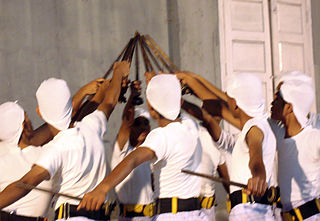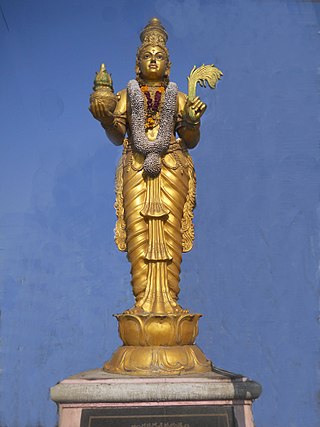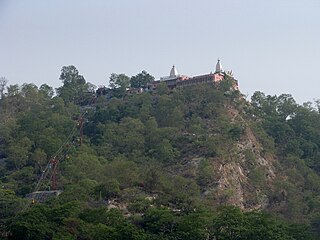
Andhra Pradesh is a state in the southern coastal region of India. It is the seventh-largest state with an area of 162,970 km2 (62,920 sq mi) and the tenth-most populous state with 49,577,103 inhabitants. It shares borders with Chhattisgarh, Odisha, Karnataka, Tamil Nadu, Telangana and the Bay of Bengal. It has the second-longest coastline in India at about 974 km (605 mi). After existence as Andhra State and unified Andhra Pradesh, the state took its present form on 2 June 2014, when the new state of Telangana was formed through bifurcation. Amaravati is the capital of the state, with the largest city being Visakhapatnam. Water sharing disputes and asset division with Telangana are not yet resolved. Telugu, one of the classical languages of India used by the majority of people, is the first official language.

Circle dance, or chain dance, is a style of social dance done in a circle, semicircle or a curved line to musical accompaniment, such as rhythm instruments and singing, and is a type of dance where anyone can join in without the need of partners. Unlike line dancing, circle dancers are in physical contact with each other; the connection is made by hand-to-hand, finger-to-finger or hands-on-shoulders, where they follow the leader around the dance floor. Ranging from gentle to energetic, the dance can be an uplifting group experience or part of a meditation.

Dance in India comprises numerous styles of dances, generally classified as classical or folk. As with other aspects of Indian culture, different forms of dances originated in different parts of India, developed according to the local traditions and also imbibed elements from other parts of the country.

Kolkali is a folk art performed in Malabar region of Kerala, India. The dance performers move in a circle, striking small sticks and keeping rhythm with special steps. The circle expands and contracts as the dance progress. The accompanying music gradually rises in pitch and the dance reaches its climax. Kolkali is now a popular event in Kerala School Kalolsavam, which is considered as the biggest cultural event of Asia. There are two styles of Kolkali: the actual Kolkali and Thekkan Koladi. The actual Kolkali consists of Thacholikali, Rajasooyam etc. The actual kolkali is almost at verge of extinction and Thekkan Koladi is still alive as it is added in state kololsavams.

Indian folk music is diverse because of India's enormous cultural diversity. It is sung in various languages and dialects throughout the length and breadth of this vast nation and exported to different parts of the world owing to migration.

Telugu people, also called Andhras, are an ethno-linguistic group who speak the Telugu language and are native to the Indian states of Andhra Pradesh, Telangana and Yanam district of Puducherry. They are the most populous of the four major Dravidian groups. Telugu is the fourth most spoken language in India and the 14th most spoken native language in the world. A significant number of Telugus also reside in the Indian states of Karnataka, Tamil Nadu, Orissa, Maharashtra. Members of the Telugu diaspora are spread across countries like United States, Australia, Malaysia, Mauritius, UAE, and others. By 2024 Telugu is spoken by 95.7 million people all over world, which makes it the third largest Indian diaspora after Hindi and Bengali. Telugu is the fastest-growing language in the United States. It is also a protected language in South Africa.

Tanuku is a Town in West Godavari district of the Indian state of Andhra Pradesh. It is the mandal headquarters of Tanuku mandal. Tanuku is 4th largest town in the West Godavari District after Bhimavaram,Tadepalligudem and Palakollu in terms of population. Tanuku is the Textile Hub of both West Godavari district and East Godavari district. There are a Significant number of Large scale and Small scale Spinning Mills
The dance forms of Andhra Pradesh take on a wide variety of colors, costumes, and types; and involve different settings and musical instruments.
Punjabi dances are an array of folk and religious dances of the Punjabi people indigenous to the Punjab region, straddling the border of India and Pakistan. The style of Punjabi dances ranges from very high energy to slow and reserved, and there are specific styles for men and women.

Tholu bommalata is the shadow puppet theatre tradition of the state of Andhra Pradesh in India with roots dating back to 3rd century BCE. Its performers are part of a group of wandering entertainers and peddlers who pass through villages during the course of a year and offer to sing ballads, tell fortunes, sell amulets, perform acrobatics, charm snakes, weave fishnets, tattoo local people and mend pots. Tholu bommalata has a history of consistent royal patronage. It is the ancestor of Wayang, the Indonesian puppet theatre play which has been a staple of Indonesian tourism and designated by UNESCO as Intangible Cultural Heritage of Humanity.
Kummi is a folk dance, popular in Tamil Nadu and Kerala in India, danced mostly by South Indian women in circle. Dancing may be different. In some places, it is very simple, with rhythmic clapping or beating of the drums. In other places dancers imitate various harvesting activities. Kummi often accompany by songs, called "Kummi songs". It is often danced during festivals. It is also danced by Tamils of Sri Lanka. Kummi songs became a popular addition to kuthiyottam festivities in modern times.

Kolattam is an ancient folk dance practiced mainly in Tamil Nadu and Kerala. It is usually performed by women using two short wooden sticks, one in each hand. The dancers generally stand in a circular formation and crisscross the sticks to make specific rhythms while singing folk songs. The dance is usually dedicated to Hindu gods or goddesses and performed during harvest season and village festivities.
2008 Bangalore serial blasts occurred on 25 July 2008 in Bangalore, India. A series of nine bombs exploded in which 1 person was killed and 20 injured. According to the Bangalore City Police, the blasts were caused by low-intensity crude bombs triggered by timers.

Mansa Devi Temple, Haridwar is a Hindu temple dedicated to goddess Mansa Devi in the holy city of Haridwar in the Uttarakhand state of India. The temple is located atop the Bilwa Parvat on the Sivalik Hills, the southernmost mountain chain of the Himalayas. The temple, also known as Bilwa Tirth is one of the Panch Tirth within Haridwar.
Nataraja Ramakrishna was an Indian dance guru. He was the chairman of Andhra Pradesh Sangeeta Nataka Academy. He was also a scholar and musicologist who promoted classical dance in Andhra Pradesh and worldwide.
Several folk dance forms evolved in different regions of Odisha, Odissi and Chhau being some popular forms. Sambalpuri dance is most popular dance of western Odisha and is enjoyed by many.

Guru Jayarama Rao is a Guru and performer of Kuchipudi style, the classical dance of Andhra Pradesh, India. He has extended the Kuchipudi repertoire.
T. D. J. Nagabhushanam was an Agricultural Economist associated initially with the Andhra University in the 1950s followed by the Andhra Pradesh Agricultural University (APAU) since the 1960s in Bapatla and Hyderabad respectively. Nagabhushanam first taught at the Agricultural College, Bapatla, which was then an affiliated entity of the Andhra University until it became a constituent College of the APAU in 1964. After nearly three decades of teaching in Bapatla, Nagabhushanam became the Principal during the 1980s after which he was made Dean of Agricultural economics and was notable for his research articles that were written over a period of nearly five decades beginning with the 1950s.











